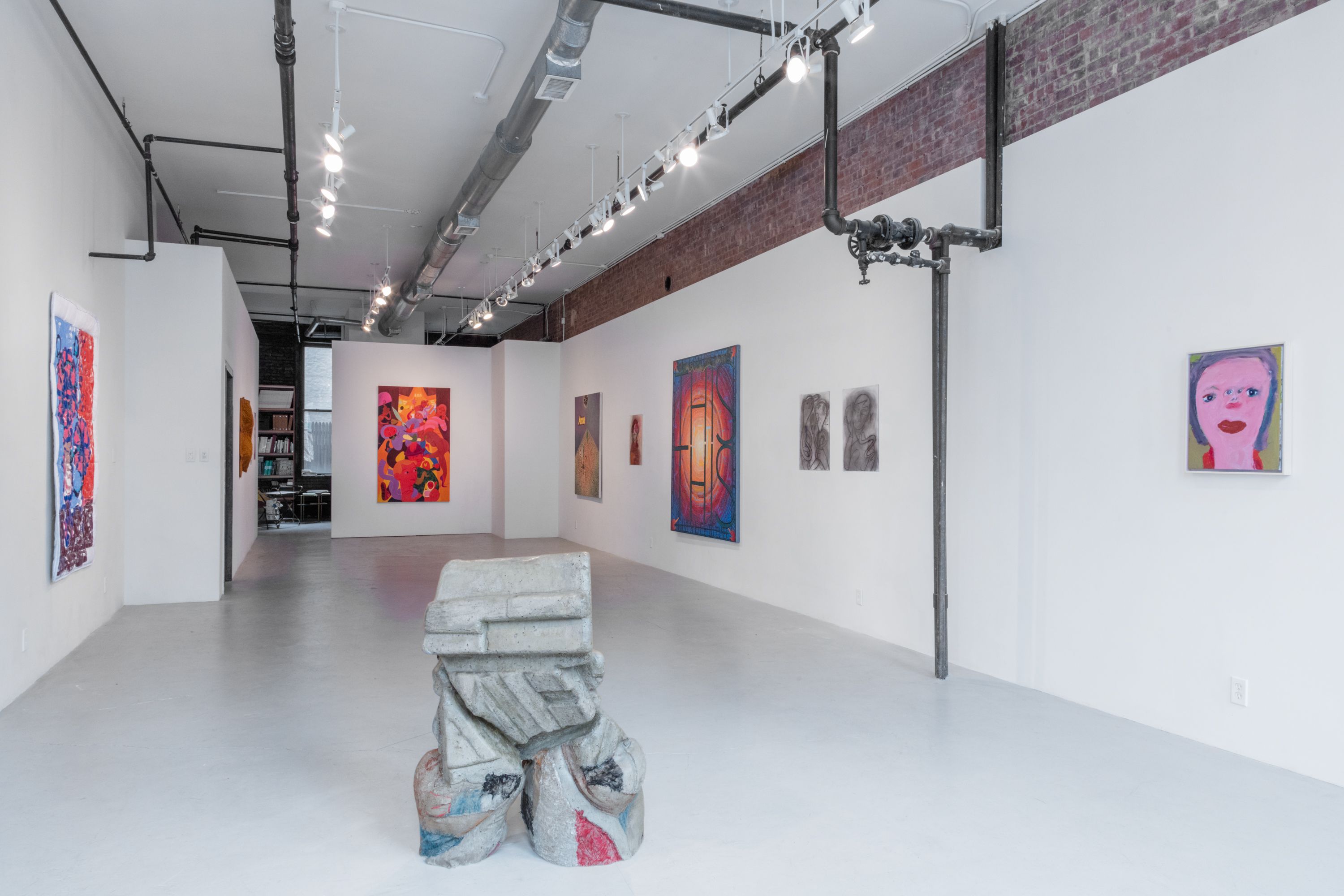The works in Surface Tension directly address the viewer, and open often surreal and at times haunting emotional landscapes. Most of the pieces play with a particular surface tension, as if the layers of paint, concrete or metal hold back a welling intensity of sensation. Each work complexly presents the inner lives of individuals and things; it is never one sentiment but rather many, all of equal value, all scratching to break through the visceral plane of the painting or sculpture. Gavin Kenyon’s sculptural and wall-based works are deeply physical gestures that balance moments of chance and control. They present a sense of containment: either in the way the quilted fabric on the wall has been solidified, or how the specific form of the sculptures envelops a particular object. In all of his pieces there is the palpable sense of torqued energy waiting to explode. It is this quality of pressure that defines the portraits of octogenarian Margot Bergman. Her skillfully arranged compositions suggest Willem de Kooning or Maria Lassnig, and her push-and-pull of the paint, sometimes gives the impression that it slides off the canvas. Bergman’s pictorial mash-ups allow her to explore the permutations of multiple facial gestures and moods simultaneously: all the complexity of emotions that make up an individual pulsates beneath her surfaces.Grace Weaver’s paintings go through various iterations before they convey the kind of atmosphere she desires. She achieves her strangely evocative sentiments by both the bold juxtaposition of color and through a critique of such socially pervasive ideas as “cuteness” and “girliness.” Weaver’s elusive narratives is a quality found in the paintings of Anna Glantz, whose compositions seem steeped in Modernist art history: de Chirico, Matisse, and others who depicted interior worlds both mental and physical. In Glantz’s paintings figuration collides with abstraction to form images and associations that hint at a hard to express alienation. Philip Hanson’s hallucinatory paintings generate similar other worldly vibes as Glantz’s. Often associated with the Chicago Imagists, Hanson unites the verbal and the visual in a tense harmony. In paintings that look like they were made by William Blake—assuming he came of age in psychedelic 1960s America—Hanson combines lines from poems with densely layered abstract forms. The linguistic and the pictorial blend into one, contorting and contending until they seem indivisible.

Installation view, Surface Tension, Simone Subal Gallery, New York, 2016.

Installation view, Surface Tension, Simone Subal Gallery, New York, 2016.

Installation view, Surface Tension, Simone Subal Gallery, New York, 2016.

Installation view, Surface Tension, Simone Subal Gallery, New York, 2016.

Installation view, Surface Tension, Simone Subal Gallery, New York, 2016.

Installation view, Surface Tension, Simone Subal Gallery, New York, 2016.

Installation view, Surface Tension, Simone Subal Gallery, New York, 2016.

Installation view, Surface Tension, Simone Subal Gallery, New York, 2016.

Installation view, Surface Tension, Simone Subal Gallery, New York, 2016.

Installation view, Surface Tension, Simone Subal Gallery, New York, 2016.

Gavin Kenyon. Untitled, 2015. Cast iron. 35 1/2 x 27 x 4 3/4 inches (90.2 x 68.6 x 12.1 cm).

Margot Bergman. Lulu, 2012. Acrylic on found canvas. 24 x 17 3/4 inches (61 x 45 cm).

Grace Weaver. city girl, 2016. Oil on linen. 72 x 43 inches (182.9 x 109.2 cm).

Anna Glantz. Anna, 2016. Oil on canvas. 56 x 46 inches (142.2 x 116.8 cm).

Grace Weaver. introvert, 2016. Charcoal on paper.

Philip Hanson. Sonnet 18 (Shakespeare), 2013. Oil on canvas. 72 x 60 inches (182.9 x 152.4 cm).

Grace Weaver. independent (life lessons taken from Beyoncé), 2016. Charcoal on paper.

Grace Weaver. long distance, 2016. Charcoal on paper. 24 x 18 inches (61 x 45.7 cm).

Margot Bergman. Jewel, 2011. Acrylic on found canvas. 20 x 16 inches (50.8 x 40.6 cm).

Gavin Kenyon. Untitled, 2016. Reinforced concrete, fur, pigment. 39.5 x 28.5 x 28 inches (100.3 x 72.4 x 71 cm).

Gavin Kenyon. Untitled, 2016. Reinforced concrete, fur, pigment. 39.5 x 28.5 x 28 inches (100.3 x 72.4 x 71 cm).

Philip Hanson. After great pain (Dickinson), 2013. Oil on canvas. 33 3/4 x 33 3/4 inches (85.7 x 85.7 cm).

Anna Glantz. Horse and Rider, 2016. Oil on canvas. 56 x 46 inches (142.2 x 116.8 cm).

Gavin Kenyon. Untitled, 2015. Quilted painting. 69 x 52 inches (175.3 x 132.1 cm).



























































































